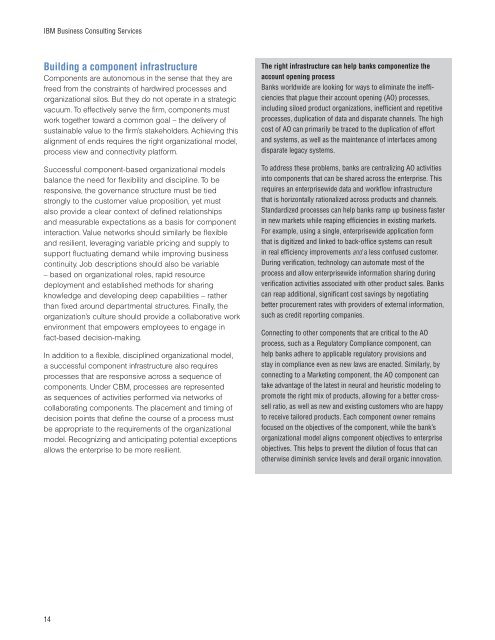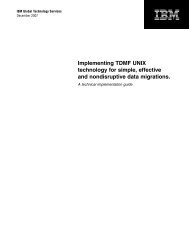Component business models - IBM
Component business models - IBM
Component business models - IBM
You also want an ePaper? Increase the reach of your titles
YUMPU automatically turns print PDFs into web optimized ePapers that Google loves.
<strong>IBM</strong> Business Consulting Services<br />
Building a component infrastructure<br />
<strong>Component</strong>s are autonomous in the sense that they are<br />
freed from the constraints of hardwired processes and<br />
organizational silos. But they do not operate in a strategic<br />
vacuum. To effectively serve the firm, components must<br />
work together toward a common goal – the delivery of<br />
sustainable value to the firm’s stakeholders. Achieving this<br />
alignment of ends requires the right organizational model,<br />
process view and connectivity platform.<br />
Successful component-based organizational <strong>models</strong><br />
balance the need for flexibility and discipline. To be<br />
responsive, the governance structure must be tied<br />
strongly to the customer value proposition, yet must<br />
also provide a clear context of defined relationships<br />
and measurable expectations as a basis for component<br />
interaction. Value networks should similarly be flexible<br />
and resilient, leveraging variable pricing and supply to<br />
support fluctuating demand while improving <strong>business</strong><br />
continuity. Job descriptions should also be variable<br />
– based on organizational roles, rapid resource<br />
deployment and established methods for sharing<br />
knowledge and developing deep capabilities – rather<br />
than fixed around departmental structures. Finally, the<br />
organization’s culture should provide a collaborative work<br />
environment that empowers employees to engage in<br />
fact-based decision-making.<br />
In addition to a flexible, disciplined organizational model,<br />
a successful component infrastructure also requires<br />
processes that are responsive across a sequence of<br />
components. Under CBM, processes are represented<br />
as sequences of activities performed via networks of<br />
collaborating components. The placement and timing of<br />
decision points that define the course of a process must<br />
be appropriate to the requirements of the organizational<br />
model. Recognizing and anticipating potential exceptions<br />
allows the enterprise to be more resilient.<br />
14<br />
The right infrastructure can help banks componentize the<br />
account opening process<br />
Banks worldwide are looking for ways to eliminate the inefficiencies<br />
that plague their account opening (AO) processes,<br />
including siloed product organizations, inefficient and repetitive<br />
processes, duplication of data and disparate channels. The high<br />
cost of AO can primarily be traced to the duplication of effort<br />
and systems, as well as the maintenance of interfaces among<br />
disparate legacy systems.<br />
To address these problems, banks are centralizing AO activities<br />
into components that can be shared across the enterprise. This<br />
requires an enterprisewide data and workflow infrastructure<br />
that is horizontally rationalized across products and channels.<br />
Standardized processes can help banks ramp up <strong>business</strong> faster<br />
in new markets while reaping efficiencies in existing markets.<br />
For example, using a single, enterprisewide application form<br />
that is digitized and linked to back-office systems can result<br />
in real efficiency improvements and a less confused customer.<br />
During verification, technology can automate most of the<br />
process and allow enterprisewide information sharing during<br />
verification activities associated with other product sales. Banks<br />
can reap additional, significant cost savings by negotiating<br />
better procurement rates with providers of external information,<br />
such as credit reporting companies.<br />
Connecting to other components that are critical to the AO<br />
process, such as a Regulatory Compliance component, can<br />
help banks adhere to applicable regulatory provisions and<br />
stay in compliance even as new laws are enacted. Similarly, by<br />
connecting to a Marketing component, the AO component can<br />
take advantage of the latest in neural and heuristic modeling to<br />
promote the right mix of products, allowing for a better crosssell<br />
ratio, as well as new and existing customers who are happy<br />
to receive tailored products. Each component owner remains<br />
focused on the objectives of the component, while the bank’s<br />
organizational model aligns component objectives to enterprise<br />
objectives. This helps to prevent the dilution of focus that can<br />
otherwise diminish service levels and derail organic innovation.

















